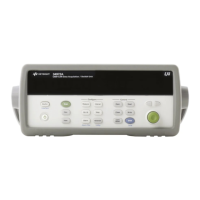7Tutorial
268 Keysight 34970A/34972A User’s Guide
System Cabling and Connections
This section describes methods to reduce measurement errors that can be
introduced by your system cabling. Many system cabling errors can be reduced or
eliminated by selecting the proper cable and grounding scheme for your system.
Cable Specifications
A wide variety of general-purpose and custom cables are available. The following
factors influence the type of cable that you choose.
– Signal Requirements – such as voltage, frequency, accuracy, and
measurement speed.
– Interconnection Requirements – such as wire sizes, cable lengths, and cable
routing.
– Maintenance Requirements – such as intermediate connectors, cable
terminations, strain relief, cable lengths, and cable routing.
Cables are specified in a variety of ways. Be sure to check the following
specifications for the cable type you intend to use (continued on the following
page).
– Nominal Impedance (insulation resistance) – Varies with the frequency of the
input signal. Check for HI-to-LO, channel-tochannel, and HI- or LO-to-shield.
High frequency RF applications have exact requirements for cable impedance.
– Dielectric Withstand Voltage – Must be high enough for your application.
– Cable Resistance – Varies with wire gauge size and cable length. Use the
largest gauge wire possible and try to keep the cable lengths as short as
possible to minimize the cable resistance. The following table lists typical
cable resistance for copper wire of several gauge sizes (the temperature
coefficient for copper wire is 0.35% per °C).
To prevent electrical shock or equipment damage, insulate all channels to
the highest potential in the system. It is recommended that you use wire with
600 V rated insulation.

